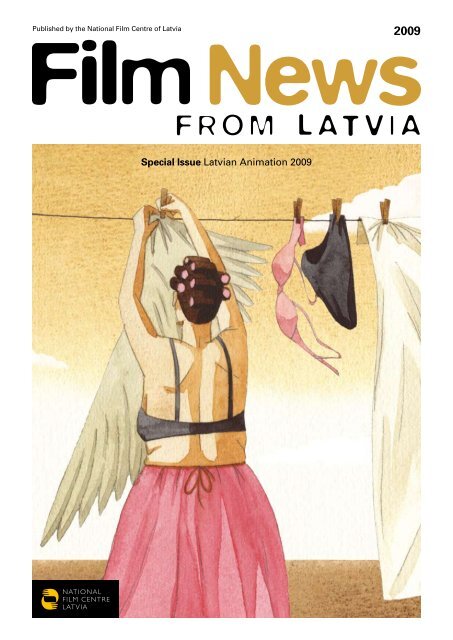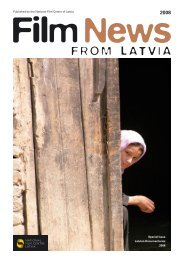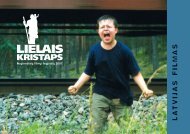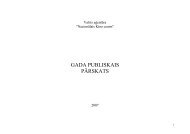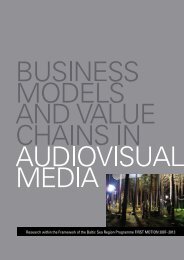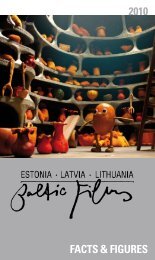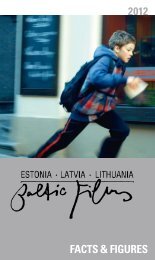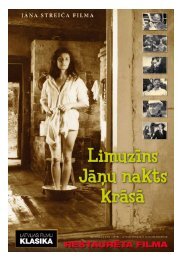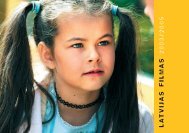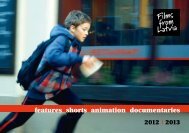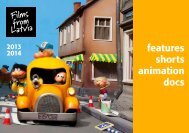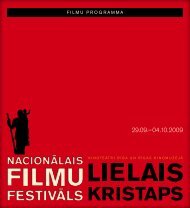Latvian Animation - NacionÄlais Kino centrs
Latvian Animation - NacionÄlais Kino centrs
Latvian Animation - NacionÄlais Kino centrs
You also want an ePaper? Increase the reach of your titles
YUMPU automatically turns print PDFs into web optimized ePapers that Google loves.
Published by the National Film Centre of Latvia<br />
2009<br />
FROM LATVIA<br />
Special Issue <strong>Latvian</strong> <strong>Animation</strong> 2009
LATVIAN<br />
ANIMATION<br />
CONTENTS<br />
Special Issue<br />
<strong>Latvian</strong><br />
<strong>Animation</strong><br />
2009<br />
Front Cover Wings and Oars<br />
Editor Zigita Saulīte<br />
Text Kristīne Matīsa, Zane Dzene, Agnese Surkova<br />
Contributors Līga Miezīte Jensena, Lelda Ozola<br />
Language Editor Sarma Māra Gaide<br />
Design and Layout Arnis Grinbergs<br />
Photos Agnese Zeltiņa and from the archive of the National Film Centre of Latvia<br />
Printer Apgāds Imanta<br />
© National Film Centre of Latvia and Media Desk Latvia, 2009<br />
2 2<br />
FN | 1
Kristīne Matīsa<br />
Editor, Film Magazine <strong>Kino</strong> Raksti<br />
Vladimir Leschiov.<br />
Some Notes on<br />
<strong>Animation</strong>.<br />
Although the producer,<br />
director and animator<br />
of the studio Lunohod,<br />
Vladimir Leschiov, has<br />
worked professionally<br />
in animation only since<br />
2004, all of his five films have received a<br />
lot of acclaim on the international film<br />
festival circuit. Vladimir Leschiov’s films<br />
can be described as philosophical, visually<br />
exquisite, poetic and with a surreal<br />
touch. His first two films, The Letter and<br />
Grandad’s Honey, were created while<br />
studying animation in Sweden in 2002.<br />
Both next, professional animated short<br />
films, Insomnia and Lost in Snow, were<br />
screened at a record number of festivals<br />
(the latter has been screened at about 70<br />
festivals!) collecting several awards. His<br />
latest film, Wings and Oars, has been<br />
included in the official program of short<br />
animation films at the prestigious Annecy<br />
<strong>Animation</strong> Festival 2009. Celebrating<br />
this achievement we invited the<br />
director to a conversation, resulting in<br />
these notes.<br />
Annecy and<br />
other festivals<br />
The Annecy festival for animators is<br />
the same as Cannes is for features. Yes,<br />
it’s relevant for me, not as sport, but<br />
because it really is the most relevant<br />
festival and an achievement. I can’t really<br />
determine how deserving my film<br />
Spārni un Airi (Wings and Oars) is to be<br />
included in the competition, because<br />
any festival is a lottery and the jury is<br />
made up of the most diverse people.<br />
I’ll say this though, I’m much more<br />
satisfied with Spārni un Airi compared<br />
to previous films – not completely, of<br />
course, but still. When I finished editing<br />
and took a look, I watched it with<br />
great pleasure, and any doubts about<br />
using such an unpredictable medium –<br />
watercolour - disappeared.<br />
Hiroshima is the second largest animation<br />
festival in the world – when I<br />
was studying and making my first film,<br />
I could only dream of showing my<br />
work at that festival. And look, Vectēva<br />
medus (Grandad’s Honey) made it into<br />
two of Hiroshima’s competition programs<br />
in the first year, one for students<br />
and the main one. Two years later Bezmiegs<br />
(Insomnia) was in competition<br />
and won an award, and after two more<br />
years Zuduši sniegā (Lost in Snow)<br />
was again in competition and won an<br />
award. If you consider that the Hiroshima<br />
festival takes place every two years,<br />
I receive an award each time! I joke<br />
with my friends – maybe the Japanese<br />
really love me. I’ve read a lot about the<br />
East and still have great interest, so<br />
perhaps they feel that.<br />
Being at the festivals is a great opportunity<br />
to find partnerships for the<br />
future if I decide to work on a serious<br />
project, moreover, my participation<br />
is great baggage – if I decide to work<br />
with someone and he asks who I am, I<br />
have only to show my CV, and all will<br />
be clear.<br />
But the most important thing is to see<br />
good films and meet people who have<br />
made the films, to discover what they<br />
think and how they work. If you don’t<br />
see the director and don’t find out<br />
anything about him, that lowers the<br />
festival’s level.<br />
On animation:<br />
the author’s signature<br />
and animation<br />
technology<br />
I would, of course, like to create my own<br />
signature and recognizable style, but<br />
somehow it hasn’t worked out. When I<br />
think about a new story, technology is<br />
one of the most important factors for<br />
me that determines the rest of it. If I<br />
don’t feel the plot in pencil, I must go to<br />
watercolour, and vice versa. Secondly,<br />
and what’s also interesting for me –<br />
there are so many techniques in the<br />
world, so why shouldn’t I try something<br />
new? I like to experiment, and my signature<br />
can be recognized elsewhere – in<br />
the film’s language and plot.<br />
There is an episode in each of my films<br />
that wasn’t planned on at first concept<br />
and framing. Sometimes the film is<br />
finished and I look at it and see – ah, I<br />
need something like this here…In the<br />
film Zuduši sniegā the episode was the<br />
moment when the man throws off the<br />
coat and jumps into the water, and in<br />
Bezmiegs it was when the woman appears<br />
in the window…It’s like preparing<br />
food – it’s ready, you taste it, but<br />
think it still needs something else...you<br />
rummage through the spice rack and<br />
suddenly find the right pepper!<br />
I don’t agree with the idea that a film<br />
needs only one main character – every<br />
good film has to have at least one<br />
character that appears, disappears, and<br />
we don’t know anything about him -<br />
it’s Fellini’s finest trick. If you’re filming<br />
on the street, then the usual way is to<br />
seal the whole block off with police<br />
tape, have actors in all the windows,<br />
and lock the doors so that there are no<br />
mishaps – we’re filming! But in a Fellini<br />
film, suddenly, calmly, in the middle<br />
of a scene, a second storey window<br />
flies open and a rotund Italian woman<br />
shakes out her enormous drawers,<br />
fastens them to the laundry line and<br />
shuts the window. And that lends<br />
credibility to the rest of what happens<br />
in the scene, that’s Fellini’s realism.<br />
<strong>Animation</strong> brings everything to life<br />
– old photographs, interviews, drawings…but<br />
it isn’t anything radical – it’s<br />
simply one of the ways it can be done.<br />
And documentary animation is actually<br />
an even easier method – if you have,<br />
for example, old albums with photos<br />
or drawings, you already have a readymade<br />
film setting and a world that<br />
doesn’t have to be constructed from<br />
scratch, just brought to life. But when<br />
you start from zero with a storyboard<br />
and frames, you have to depict each<br />
detail of a completely new world that<br />
Wings and Oars<br />
hasn’t previously existed, only in your<br />
fantasy, and that is a very lengthy and<br />
serious process.<br />
I don’t see how 3D animation can develop.<br />
You can experiment with other<br />
animation methods and figure out new<br />
ways, but with this it isn’t possible –<br />
your new animation medium is your<br />
newest super computer, and you have<br />
to buy an even newer and better one<br />
next year. That’s simply the development<br />
of equipment, not animation.<br />
Okay, you’ll have even more perfect<br />
lighting and precise movement, and<br />
finally we won’t be able to tell the difference<br />
between 3D animation and<br />
reality – but what’s the point?! A few<br />
years ago the Americans said – it’s going<br />
to be great, soon we won’t have to<br />
pay actors huge salaries, we can make<br />
anything in 3D. But who will want to<br />
watch something synthetic with no life?<br />
Schools of Art<br />
and Life<br />
At this point I’m more or less trying to<br />
forget everything I learned at the Jānis<br />
Rozentāls Art School, because sometimes<br />
when I draw something freely as<br />
I feel it, the knowledge slowly starts to<br />
creep in, and it ends up being too correct.<br />
I feel an image and I know how<br />
it should move, but knowledge of correct<br />
proportions messes about in my<br />
head… I can animate any image, even<br />
those that don’t exist in reality; I know<br />
what the internal skeleton is or should<br />
be. But sometimes I need to work freely,<br />
and it’s not easy.<br />
When I finished school, my teacher<br />
said that I would definitely get into the<br />
graphics department at the Art Academy<br />
of Latvia. After the entrance exams<br />
– never in my life have I’ve been as sure<br />
of something as when I went to see my<br />
results. I was sure I was in, but when<br />
I saw the results…at first I thought it<br />
was a mistake, and at that time it only<br />
meant one thing – off to the army. I<br />
went to the enlistment office and the<br />
officer was gleeful – so Leschiov, didn’t<br />
get in? Here you go – Severnij flot in<br />
Murmansk…I didn’t serve the whole<br />
three years though, as it was the end of<br />
the 80s and they let us go home after<br />
two. I returned, no one needed me, and<br />
I had forgotten how to draw…I worked<br />
in advertising for a time and made the<br />
first 3D graphics even though I didn’t<br />
know anything about computers. And<br />
so I worked and worked, going from<br />
FN | 2<br />
2<br />
FN | 3
Vladimir Leschiov. Some Notes on <strong>Animation</strong>.<br />
Photo: A. Zeltiņa<br />
job to job, company to company, collecting<br />
experience and growing.<br />
In the mid-90s I began exploring animation,<br />
trying out plasticine, using<br />
a computer, and found I really liked<br />
doing it. I began pitching animation<br />
for ads – if a client let me I made an<br />
animated clip, but I soon understood<br />
that I was subjected to other’s tastes<br />
– to what the agency and the client<br />
wanted…I wanted to do my own thing<br />
and had already started making a film<br />
during my free time. After a while I<br />
knew I would never finish the film this<br />
Vladimir<br />
Leschiov<br />
Vladimir Leschiov was born in 1970.<br />
He finished the Jānis Rozentāls Art<br />
School in Riga in 1989, and studied<br />
animation at Konstfack University<br />
College of Arts, Crafts and Design in<br />
Sweden. Since 1992 he has worked as<br />
an illustrator, designer and art director<br />
on commercials in Latvia. From 2004 he<br />
has worked professionally in animation,<br />
and since 2005 he teaches animation<br />
at the Art Academy of Latvia. After<br />
working at the larger <strong>Latvian</strong> animation<br />
studios - Rija Films and Jet Media – he<br />
established his own animation studio,<br />
Lunohod, in 2007.<br />
Filmography:<br />
Wings and Oars, 2009<br />
Lost in Snow, 2007<br />
Insomnia, 2004<br />
Grandad’s Honey, 2002<br />
The Letter, 2002<br />
way, so I had to decide what I really<br />
want – to work in advertising or make<br />
films. There are a lot of people like<br />
that in advertising – they really want to<br />
make films and say, that’s it, one last ad<br />
and I’m off to write a script. And they<br />
say that every day for years!<br />
It took quite a while for me and it was<br />
even a bit painful, because once a decision<br />
like that is made, suddenly there<br />
is no more income. But finally I started<br />
looking for a school where I could learn<br />
animation – one not too far away and<br />
where I didn’t have to pay. I found a<br />
school in Sweden where I was accepted<br />
into the graduate program right away<br />
because I had submitted my work – the<br />
ads, the clips, my own attempts…<br />
It’s better to work in my home country;<br />
I’ve tested this out. In Sweden I<br />
didn’t have to worry about the lack of<br />
anything – if you don’t have the right<br />
pencil, sign up and the next morning<br />
you’ll receive a packet of pencils,<br />
nicely wrapped, inscribed with your<br />
last name and a smiley face…Here you<br />
have to fight for every pencil, but even<br />
so it’s more interesting. That’s why I<br />
like it in Latvia – everything here is absurd<br />
and illogical, that’s why foreigners<br />
think my films are strange, but I’m not<br />
making it up, I show it like it is. I don’t<br />
feel as good in Sweden or Germany because<br />
everything there is clear, logical,<br />
and too correct.<br />
His Own Studio –<br />
There are many reasons why I can’t<br />
work in someone’s studio. I’m a huge<br />
egoist in regards to my work, and if I’m<br />
doing a project, it’s important that the<br />
very best people with the most serious<br />
attitude are involved. And in big<br />
studios three or four projects are going<br />
in parallel, and if the situation on one<br />
suddenly becomes intense, then the<br />
best people are mobilized for that one<br />
project and the others almost stop. It’s<br />
very disruptive and doesn’t benefit any<br />
of the projects. An animator is an actor<br />
who has to grow into a character until<br />
he knows it and feels it completely. If<br />
he’s suddenly yanked away and put<br />
into a different character, and then<br />
released after two months, he has, in<br />
the meantime, forgotten the feel of my<br />
film and time is wasted reviving that. It<br />
isn’t normal, it’s not the way to work, at<br />
least not for me. I’m the king and dictator<br />
where I work, that’s just how it is.<br />
I spent a long time thinking about<br />
a name for my studio – I couldn’t<br />
use my last name as it’s difficult for<br />
foreigners to say. I knew I needed<br />
something not from this world. I was<br />
born in 1970, right when the lunohod<br />
landed on the Moon (in 1970 the Soviet<br />
lunar-rover Lunohod-1 landed on<br />
the surface of the Moon – ed.)<br />
I’ve heard talk that Lunohod is one of<br />
the biggest studios in the Baltics, and I<br />
also read in a serious animation portal<br />
that Vladimirs Leschiov has established<br />
his own studio. Someone is obviously<br />
following what I’m doing, and<br />
it’s really interesting to discover that<br />
– almost like standing behind a door<br />
and listening to what others are saying<br />
about you. That’s what happened during<br />
Bezmiegs when I was still unknown<br />
at the festivals – I’m standing beside<br />
a famous French director who says to<br />
his colleague that Bezmiegs is a very<br />
interesting film, fresh and new, but<br />
the director must be on some kind of<br />
drugs…And literally a few hours later<br />
someone introduced us and then he<br />
felt a bit uncomfortable because he<br />
had seen me earlier, and I told him I<br />
don’t do drugs…<br />
Future <strong>Animation</strong><br />
Projects<br />
I think I could make a feature-length<br />
animation film at some point, a series,<br />
or animation for children, but I’m<br />
not ready yet, as, truthfully, it’s a very<br />
serious undertaking. There’s no point<br />
in making a feature-length film that<br />
isn’t commercially viable; it’s too big a<br />
project to fool around with.<br />
If someone asks why I don’t make<br />
films for children, the only answer is<br />
– it’s the most serious audience. It’s<br />
not as risky making films for adults,<br />
but children perceive the world very<br />
deeply and directly, and that’s a<br />
huge responsibility. The other thing<br />
is that children now are different<br />
than we were, and they know and<br />
have experienced much more. That’s<br />
why creating stories for them about<br />
bears and foxes is no longer relevant<br />
– they know a different world, of robots,<br />
killers and ninjas. I’m not really<br />
interested in working with foxes<br />
or killers, and I’ve yet to discover a<br />
world I want to show children. That’s<br />
why I’m doing more passive exploration<br />
now and looking at what might<br />
work in the future.<br />
FN | 4 FN | 5
Agnese Surkova, Film Critic<br />
<strong>Latvian</strong> <strong>Animation</strong><br />
RIJA<br />
DAUKA<br />
■ In spite of the hard times, one of<br />
Latvia’s oldest and most experienced<br />
animation film studios, Dauka, has kept<br />
up its fine spirit and resilience. Established<br />
in 1969 by Roze Stiebra and Ansis<br />
Bērziņš, the studio’s contribution to<br />
<strong>Latvian</strong> animation is already considered<br />
part of cultural heritage.<br />
Just recently, studio Dauka’s animators,<br />
overseen by Roze Stiebra and<br />
Ansis Bērziņš, finished eight months<br />
of work on their latest film. 2D animation<br />
film Dzeguze un viņas 12 vīri<br />
■ Studio Rija Films animators are<br />
always busy and the activity is noticeable<br />
enough that the phrase “economic<br />
crisis” doesn’t seem to apply. Founded<br />
in 1995, Rija, perhaps the best<br />
internationally-known <strong>Latvian</strong> film<br />
studio, keeps making co-productions,<br />
and is currently working on two new<br />
features. Continuing their successful<br />
collaboration with the Estonian studio<br />
Joonisfilm, Rija promises, in the next<br />
year, to release the continuation of the<br />
adventures of much loved puppy-girl<br />
Lotte, in the animation film Lote un<br />
Mēness akmens noslēpums (Lotte and<br />
the Moonstone Secret). A few intriguing<br />
plot secrets have come to light –<br />
Lotte and her friends will meet some<br />
unknown Moon dwellers, and the film<br />
will feature at least two new songs from<br />
the band Prāta Vētra (Brainstorm).<br />
Immediately after Lotte, the next<br />
project will be an animated version of<br />
the play Zelta Zirgs (Golden Horse) by<br />
Jānis Rainis, meant for the whole family.<br />
Producer Vilnis Kalnaellis anticipates<br />
that Zelta Zirgs (MEDIA Development<br />
Support) will be a feature-length<br />
animation that fits with Rija’s internationally<br />
recognized image: national<br />
in content, international in form. On<br />
board is director Signe Baumane who<br />
has worked for many, creatively-rich<br />
years in the US, and Xavier Dujardin, a<br />
character artist from Belgium, who is<br />
lesser known to <strong>Latvian</strong> viewers.<br />
Even though Rija Films has had<br />
plenty of success in international coproductions,<br />
there is also a bounty of<br />
home-grown animation in its wings. The<br />
beginning of 2009 saw the international<br />
premiere of Reinis Kalnaellis’ debut film<br />
Kad āboli ripo (When Apples Roll) at the<br />
59 th Berlinale film festival, and just now<br />
in April, the 2D animation film did the<br />
rounds of six international festivals – in<br />
Greece, Germany, the USA, Turkey, Italy<br />
and here in Latvia, at the Berimora kino<br />
festival. In addition, the film has received<br />
an invitation to participate in France’s<br />
Annecy Plus, founded by Bill Plympton.<br />
With positive reviews, an abundance of<br />
ideas and zeal, there’s no standing still;<br />
Vilnis Kalnaellis thinks that work will<br />
soon begin on another new animation<br />
film - a sequel to Kad āboli ripo, but this<br />
time in feature length.<br />
Working at the same pace as till<br />
now, studio Rija hopes to finish two<br />
more <strong>Latvian</strong> animation films by the<br />
fall. Viewers will first be offered a 3D<br />
(The Cuckoo and her 12 Hubbies), is a<br />
comic story with Pēteris Brūveris’ poetry<br />
about Dzeguze’s romantic adventures.<br />
Through Roze Stiebra’s direction and<br />
her screenplay, Dzeguze is full of rich,<br />
colourful visual imagery created by artist<br />
Gundega Muzikante, with an equally<br />
colourful original score by composer<br />
Mārtiņš Brauns.<br />
The studio’s founders would be<br />
happy to accept new professionals into<br />
their small, experienced collective,<br />
and in order to train skilled animators<br />
they’ve organized year-long courses for<br />
five promising youths. Roze Stiebra emphasizes<br />
that Dauka is a workshop type<br />
of studio – small, open to creative ideas,<br />
animation, Skatu meklētājs (View Finder),<br />
by Pēteris Noviks, a story about<br />
a blind person’s insights and radiant<br />
daydreams while waiting for the green<br />
light at a crossing. Soon after that, the<br />
2D animation, Norīt krupi (To Swallow<br />
a Toad), will be ready, and directorartist<br />
Jurģis Krāsons’ signature will now<br />
be in colour [his 2006, internationally<br />
recognized animation film, Melnā kaste<br />
(Black Box), was in black & white].<br />
Not waiting on the creation of an<br />
animation school in Latvia, the studio<br />
organizes animation courses on its<br />
own, and helps young artists in their<br />
craft. Vilnis Kalnaellis promises that<br />
Rija will continue to provide opportunities<br />
for the expression of animation<br />
ideas that are new, original, and able<br />
to compete internationally – some of<br />
those will take shape very soon.<br />
Golden Horse<br />
and willing to train those interested.<br />
And as the fall will once again be busy<br />
– financing for a new animation film<br />
was granted by the State Culture Capital<br />
Foundation – one of the upcoming animators<br />
will have a chance to show their<br />
skills. Roze Stiebra’s assistant on her<br />
latest project is Miks Straume, a student<br />
from the Baltic International Academy.<br />
Inga Actiņa, whose drawings the director<br />
characterizes as spirited caricatures,<br />
will be the film’s artist. Pre-production<br />
has begun, and the studio promises to<br />
showcase a new and thrilling 2D animation<br />
film - Kā brālītis trusītis uzvarēja<br />
lauvu (Brer Rabbit and Boss Lion). This<br />
will be the fourth story in the Dauka<br />
ANIMĀCIJAS<br />
BRIGĀDE<br />
■ The studio that is continuing the<br />
tradition of animation master Arnolds<br />
Burovs’ puppet film studio founded in<br />
1966, currently has more than ten associates.<br />
The small collective will soon<br />
finish work on two new puppet animation<br />
films. Soon too, sound will be<br />
added to the 35mm film Cūkas laime<br />
(Pig’s Happiness), by director Dace<br />
Rīdūze and artist Ieva Kauliņa - a jolly<br />
story about a city pig family’s vacation<br />
in the countryside.<br />
Master of Ice<br />
JURIS PODNIEKS<br />
STUDIO<br />
■ STUDIJA CENTRUMS and the producer<br />
Bruno Aščuks have begun their<br />
activities by releasing the first ever<br />
<strong>Latvian</strong> documentary animation Little<br />
Bird’s Diary – an exceptional life story<br />
told through animated drawings of<br />
the main character – 80 years old Irina<br />
Piļķe. Another docu-animation is in the<br />
pipeline – this time based on the drawings<br />
from exile in Siberia.<br />
Studio JET MEDIA is developing<br />
a series of 2D/3D animation Tales of<br />
the Sunrise Tree (MEDIA Development<br />
Support and co-production with Slovenia).<br />
Another series by this company<br />
Weasymartenette has also got MEDIA<br />
Development Support and is in an<br />
early development stage.<br />
SIGNE BAUMANE, the internationally<br />
acknowledged <strong>Latvian</strong> animation<br />
film director, Member of the American<br />
Motion Pictures Association, is working<br />
By mid 2009, the studio also plans<br />
to finish director Ēvalds Lācis’ newest<br />
achievement – a magical story about<br />
love and saving a princess, called Ledus<br />
pavēlnieks (Master of Ice). Jānis Cimermanis,<br />
one of the film’s animators,<br />
tells us that the story will have many<br />
visually impressive marvels that computer<br />
artist Andris Gailītis is helping to<br />
create. As soon as the digital processing<br />
of the film is done, composer Juris Kulakovs<br />
will begin his work.<br />
Animācijas Brigāde is currently<br />
preparing for a large-scale co-production<br />
project – the shooting of the<br />
feature-length film Mežonīgie pīrāgi<br />
(The Wild Pirogi), (MEDIA Development<br />
Support). The screenplay author<br />
and artist is Māris Putniņš, with director<br />
Jānis Cimermanis, who reveals<br />
that 20 dolls have already been made<br />
for the film, and a 3 minute film clip<br />
will be finished shortly. He added that<br />
Mežonīgie pīrāgi will be a romantic,<br />
adventure-filled pirate story with a<br />
happy ending, but it won’t be the end<br />
of the adventures of the pīrāgi – the<br />
■ The heart and soul of animation<br />
at the Juris Podnieks Studio is Nils<br />
Skapāns. One of the most notable international<br />
achievements of Nils Skapāns’<br />
claymation films was the Crystal Bear at<br />
the Berlinale for the 1994 film Lidojam?!<br />
(Let’s Fly?!). Ten years later, his film,<br />
Redzi, Trusi…Tētis brauc uz Londonu<br />
(Listen, Rabbit…Daddy Goes to London,<br />
2004) was again screened at the<br />
Berlin film festival.<br />
The studio is currently creating<br />
a claymation mischief and adventure<br />
story about a day in the life of a<br />
nasty lady and her cat – Burvīga diena<br />
(Wonderful Day). The artist, helped on<br />
occasion by puppet artist Ilze Esme,<br />
hopes to finish this 15 minute film by<br />
the end of 2009.<br />
Parallel to this project, Nils<br />
Skapāns is also making claymation<br />
episodes for Pēteris Krilovs’ latest<br />
documentary, Lietus un vēji.<br />
both in Latvia and the US. Signe’s latest<br />
animation Birth has experienced its<br />
world premiere nominated for the Best<br />
Short Film at the Berlin International<br />
Film Festival 2009 and is now on its way<br />
to be screened at the Anncey Film Festival.<br />
In the meantime, Signe is working<br />
on the feature animation Golden Horse<br />
at studio Rija Films in Riga.<br />
There is a lot of production activity<br />
taking place at other animation<br />
studios as well. Studio URGA has previously<br />
produced two of director, artist<br />
and animator Kārlis Vītols’ animation<br />
films, Mehānisms (Mechanism) and<br />
Trofeja (The Trophy), and have now<br />
released an ironic, visually interesting<br />
and attractively narrated animation<br />
film, Velna Fudži (Devil’s Fuji). Several<br />
new animation films in collaboration<br />
with well-known <strong>Latvian</strong> animation<br />
directors are in the making at studio<br />
<strong>Latvian</strong> <strong>Animation</strong><br />
Coming Soon<br />
Lote un Mēness akmens noslēpums<br />
Lotte and the Moonstone Secret Rija<br />
Skatu meklētājs View Finder Rija<br />
Norīt krupi To Swallow a Toad Rija<br />
Sarkanais jātnieks Red Rider RIJA<br />
Austras koka pasakas<br />
Tales of the Sunrise Tree JET MEDIA<br />
Kā brālītis trusītis uzvarēja lauvu<br />
Brer Rabbit and Boss Lion<br />
Dauka<br />
Cūkas laime Pig’s Happiness<br />
Animācijas Brigāde<br />
Ledus pavēlnieks Master of Ice<br />
Animācijas Brigāde<br />
Burvīga diena Wonderful Day<br />
Juris Podnieks Studio<br />
Reiz Dievs... Once Upon a Time God ...<br />
Atom Art<br />
Lupatiņi Shammies Atom Art<br />
Pavasaris Vārnu ielā<br />
Springtime on Vārnu Street<br />
Atom Art<br />
Sieviete un Vējš Women and Wind<br />
A.Bley Film Studio<br />
ATOM ART. Māra Liniņa is working on<br />
a three-part animation series based<br />
on <strong>Latvian</strong> folklore on how the world<br />
was created: Reiz Dievs…(Once Upon a<br />
Time God…). Edmunds Jansons is directing<br />
two films: Lupatiņi (Shammies)<br />
and Pavasaris Vārnu ielā (Springtime<br />
on Vārnu Street). The last is a musical<br />
animation about the adventures of the<br />
children of a working-class family in<br />
19 th century Riga. Director Aija Bley has<br />
her own studio, A. BLEY FILM STU-<br />
DIO, and her latest project is an animation<br />
short, Sieviete un Vējš (Women<br />
and Wind), together with recognized<br />
artist Patrīcija Brekte - a poetic story<br />
of passionate love between a Western<br />
Woman and an Eastern Wind.<br />
It is certain that viewers both here<br />
at home and those abroad will soon get<br />
to experience a new and rich crop of<br />
<strong>Latvian</strong> animation!<br />
FN | 6 FN | 7
Zane Dzene, Film Critic<br />
Defining Moments in<br />
<strong>Latvian</strong> <strong>Animation</strong><br />
Notable animation films in <strong>Latvian</strong> film history<br />
1966 Ki-ke-ri-gū! The Cock’s Crow<br />
■ Ki-ke-ri-gū! is the first <strong>Latvian</strong> animation film. The director, Arnolds Burovs, is<br />
already well-known in <strong>Latvian</strong> culture circles, having secured a spot in the <strong>Latvian</strong><br />
theatre Olympus with achievements<br />
in puppet theatre. At the age of 50, he<br />
begins to create….animation! Burovs is<br />
the father of <strong>Latvian</strong> animation, and his<br />
traditions are now carried on by studio<br />
Animācijas Brigāde. The director’s filmography<br />
includes both <strong>Latvian</strong> folk<br />
story themes as well as classics of world<br />
literature.<br />
1969 Lietainā diena<br />
Rainy Day<br />
■ Animators at <strong>Latvian</strong> Television get<br />
into the game, and Roze Striebra, an<br />
actress from the puppet theatre together<br />
with documentary film maker and<br />
cinematographer, Ansis Bērziņš, create<br />
the first film using applique technique.<br />
This successful collaboration will later<br />
become the animation studio Dauka,<br />
with traditions focused on <strong>Latvian</strong> folklore,<br />
poetic rhythm and sincerity.<br />
1976 Caps meklē<br />
Caps in Pursuit<br />
■ Puppet master Arvīds Noriņš creates<br />
a detective story for children in a James<br />
Bond mode, solving tricky secrets one<br />
after the other. Remaining aware of his<br />
young and demanding audience, a large<br />
role is given to communism, so that the<br />
educational aspect isn’t lost, of course.<br />
1974 Dillī Dallī Perpendikula valstībā<br />
Dilly Dally in Perpendicular’s Kingdom<br />
■ The first series (films made in 1974, 1975 and 1976) in <strong>Latvian</strong> animation history,<br />
in which good and bad characters are clearly defined, and there is a special emphasis<br />
on the accompanying sound. Perpendikuls, created by artist Daina Lapiņa,<br />
becomes a scary ghost-image for young viewers!<br />
1977 Si-Si-Dra<br />
■ Thanks to Arnolds Burovs’ farsightedness,<br />
some notable caricaturists<br />
arrive at Riga Film Studio, and one of<br />
them, Gunārs Bērziņš, is responsible for<br />
this jolly film’s visual image and playfully<br />
instructional tone. The kids like<br />
it and the adults are happy that their<br />
offspring were now clear on why it’s bad<br />
to act like a pig in the forest, and what<br />
happens if one should be a “pig”.<br />
1967 Pigmalions<br />
The Pygmalion<br />
■ The legendary story is successfully<br />
re-created in the hands of Riga<br />
Film Studio director Arnolds Burovs.<br />
Though the film’s fate in Latvia is<br />
complicated, Moscow officials proudly<br />
screen it for foreign delegations, saying,<br />
look, we have modernism, symbolism<br />
and abstractionism in the Soviet<br />
Union as well…<br />
1978 Vanadziņš The Hawk<br />
■ Undoubtedly one of the all-time most beautiful <strong>Latvian</strong> animation films - the<br />
screenplay is based on themes from the stories of writer Vilis Lācis, and depicts the<br />
relationship between a small boy and<br />
his father – a seaman. The emotional<br />
portraits included in Arnolds Burovs’<br />
direction lend this tragedy the ache of<br />
human drama.<br />
1983 Kabata<br />
In My Pocket<br />
■ Latvia’s first animation film drawn<br />
on celluloid is based on themes from<br />
<strong>Latvian</strong> poet Ojārs Vācietis’ children’s<br />
poems, with a musical score by Imants<br />
Kalniņš.<br />
1991 Gulbis Swan<br />
■ Gulbis marks the beginning of Studio<br />
AB’s Avārijas Brigāde (Rescue<br />
Team) series, which quickly gains<br />
popularity not only in Latvia but also<br />
far beyond the borders, and rather<br />
convincingly showcases the talent and<br />
ability of the young artists who have<br />
come from the Arnolds Burovs’ school.<br />
The three main characters - Sīlinks,<br />
Poteriks and Bembelāts – “lend” their<br />
faces to local manufacturers for advertising<br />
purposes, and entertain viewers<br />
with their imagination and the turns<br />
of events that befall them. Soon after,<br />
Studio AB creates two more series –<br />
Munks un Lemijs (Munk and Lemmy)<br />
and Zvēri (Animals). Later on, together<br />
with the Danish studio Zentropa, they<br />
make two animated features – Props<br />
un Berta (Prop and Berta) and Trīs<br />
Musketieri (The Three Musketeers).<br />
All around success!<br />
Čapliniāna.<br />
1983 Sapnis<br />
The Dream<br />
1984 Pēdējā lapa<br />
The Last Leaf<br />
1986 Princese un<br />
puma The Princess and<br />
the Puma<br />
1981 Bimini<br />
■ A visualisation of the reflections and<br />
ideas on a poem by Heinrich Heine –<br />
the film’s title was also borrowed for<br />
a while by the only <strong>Latvian</strong> animation<br />
festival. That is long gone, but this<br />
Arnolds Burovs’ film has become a<br />
<strong>Latvian</strong> animation classic, and the music,<br />
composed by Imants Kalniņš and<br />
performed by Menuets, beckons us to a<br />
wonderland called Bimini, where there<br />
is eternal spring, and a drink from the<br />
brook’s water grants all wishes, such as<br />
restoring youth.<br />
■ Charlie Chaplin said: he’s a citizen<br />
of the world, and perhaps that is why<br />
the famous character, The Tramp, appealed to Arnolds Burovs and his team. After<br />
returning from America, Burovs is completely taken with the works of O. Henry,<br />
and begins to make films based on what he’s seen across the ocean. The events<br />
and characters are, of course, given comic notes and sentiments, which are nicely<br />
underscored by maestro Raimonds Pauls’ music.<br />
1991 Ness un Nesija Ness and Nessy<br />
■ A collaboration between almost all<br />
forces of <strong>Latvian</strong> animation creates<br />
the first <strong>Latvian</strong> animated feature -<br />
a love story based on the legendary<br />
Loch Ness Monster. Many sayings<br />
from this film have become part of<br />
spoken <strong>Latvian</strong>, but the likable hero’s<br />
name, Knipucītiņuminītiņimais<br />
Pintiķupinītis, isn’t even pronounceable.<br />
In 1993, Ness un Nesija receives<br />
a Lielais Kristaps award for best animation<br />
film.<br />
FN | 8 FN | 9
Defining Moments in <strong>Latvian</strong> <strong>Animation</strong><br />
Defining Moments in <strong>Latvian</strong> <strong>Animation</strong><br />
1991 Kā bērniņš nāk<br />
pasaulē How a Baby<br />
Comes Into the World<br />
■ The sexual revolution happened in<br />
Latvia thanks to Māris Putniņš, an artist<br />
and soon-to-be among the most<br />
visible <strong>Latvian</strong> puppet animation specialists.<br />
In 1989, he published a series<br />
of drawings showing that babies aren’t<br />
brought by storks or found in cabbage<br />
patches in the famous children’s magazine<br />
Zīlīte, This popular-science film by<br />
Roze Stiebra recreates this long-keptfrom-children<br />
truth on the big screen.<br />
1994 Aicinājums<br />
The Summons<br />
■ Studio Dauka makes a film to begin<br />
the series Pasaciņas (Little Fairy-Tales),<br />
1994 Munks un Lemijs. Lidojam?!<br />
Munk and Lemmy. Let’s Fly?!<br />
■ Director Nils Skapāns’ second film is in competition at the Berlinale Film Festival.<br />
Slightly bewildered by the turn of events and still not really knowing much<br />
about directing, he heads to one the<br />
world’s most prestigious film festivals,<br />
and becomes even more bewildered<br />
when his film wins a Crystal Bear. The<br />
award shatters into pieces in a plastic<br />
bag on the way home, but that doesn’t<br />
take away from the creator’s joy. One<br />
after the other, articles start to appear<br />
in the press praising the future of <strong>Latvian</strong><br />
animation.<br />
1998 Kiriku un burve Kirikou et la Sorciere<br />
■ Michel Ocelot’s award winning animation film Kirikou et la Sorciere (awards at<br />
Annecy <strong>Animation</strong> Film Festival, Chicago and Montreal) has names of <strong>Latvian</strong> animators<br />
in the credits. This is a successful start in the animation world arena, and is<br />
followed by work on the Oscar nominated Les triplettes de Belleville (2003).<br />
2001 Pavasaris Spring<br />
■ Nils Skapāns joins Juris Podnieks Studio and makes his first claymation film.<br />
Even though by the end of the film the snowman has become a shade of light gray,<br />
the KROK animated film festival recognizes his achievement with a special award.<br />
2002<br />
Vectēva Medus<br />
Grandad’s Honey<br />
■ Created as a graduation project at<br />
Konstfack, University College of Arts,<br />
Crafts and Design, Dept. of <strong>Animation</strong>,<br />
in Eksjo, Sweden, Vladimir Leschiov<br />
makes a notable entrance onto the<br />
<strong>Latvian</strong> animation scene. The director,<br />
having already tried his hand at<br />
making commercials, shows the local<br />
viewer a new form of drawing and<br />
in-frame detail, and convinces the national<br />
film festival Lielais Kristaps jury<br />
of his talent, as Vectēva Medus receives<br />
the award for best <strong>Latvian</strong> animation<br />
in 2003.<br />
2002 Sieviete Woman<br />
■ Signe Baumane first sat in the director’s chair in 1991 when she dared to make<br />
her dream of making animation come true. But only in 2009, after some 20 years<br />
of work, her film Dzemdības (Birth) is finally included in the Annecy film festival!<br />
Sieviete, made under the wing of Rija Films, is a philosophical study. Screened<br />
both in Woodstock and KROK, the film captivates viewers with the elusive and<br />
not wholly understandable inner world of a woman, and is in contrast with the<br />
films she creates in New York that are full of sexuality, and are often criticized by<br />
Latvia’s puritanical society.<br />
which is Roze Stiebra’s pet project.<br />
Through the more than twenty films<br />
that ensue, the viewer is introduced to<br />
<strong>Latvian</strong> stories, and popular <strong>Latvian</strong><br />
artists are brought into the world of animation – they light up the screen with<br />
shades of colours that, up to now, were only used on canvas.<br />
1999 Clara un Rubinšteins Clara and Rubinstein<br />
■ At the end of the 1990s, Askolds Saulītis is declared to be one of Latvia’s most<br />
promising young directors, and Studio Rija Films strikes while it’s hot. The first<br />
co-production film is made together<br />
with producer Paul Thiltges, who knew<br />
of the accomplishments of <strong>Latvian</strong><br />
animators from Kirikou et la Sorciere,<br />
and is, since 2008, a co-producer on<br />
Studio Rija Films’s upcoming feature<br />
Zelta Zirgs (Golden Horse). Clara un<br />
Rubinšteins is a mix of the director’s<br />
grandmother’s memories and nevermade<br />
films about excess weight. Artist<br />
Jurģis Krāsons received a Lielais<br />
Kristaps award for his work.<br />
1999 Velniņi<br />
The Little Devils<br />
■ Studio Rija Films releases Velniņi in<br />
the same year – a modernized screen<br />
version of a work by <strong>Latvian</strong> writer<br />
Rūdolfs Blaumanis, with voiceovers by<br />
local celebrities. An interactive game in<br />
CD format aimed at children follows.<br />
2003<br />
Jāņtārpiņš Firefly<br />
■ Dace Rīdūze, one of the large Studio<br />
AB family, directs Jāņtārpiņš, as part<br />
of the Animals series from Animācijas<br />
Brigāde. The film is screened at the Berlinale<br />
festival, and makes both adults<br />
and children think about tolerance. Is<br />
firefly Otis not as good as others because<br />
his glow-light doesn’t work?<br />
2004 Poēm pa kulšen<br />
■ One of rare, true cinematographic <strong>Latvian</strong> animation films is directed by Jānis<br />
Cimermanis under studio Animācijas Brigāde. The screenplay is based on a work<br />
by Fricis Dziesma published in 1948,<br />
on the tradition of grain threshing in<br />
the Kurzeme region. Alongside the human<br />
lives, there are also the joys and<br />
woes of the little animals, and the lively<br />
whirl of intertwining events carries the<br />
viewer into the distant past, perhaps<br />
recognizing the fond memories shared<br />
by their parents or grandparents.<br />
FN 2 | 10<br />
FN | 11 2
Defining Moments in <strong>Latvian</strong> <strong>Animation</strong><br />
Defining Moments in <strong>Latvian</strong> <strong>Animation</strong><br />
2004 Bezmiegs Insomnia<br />
2007 Kuģis The Ship<br />
■ One of the most internationally-known <strong>Latvian</strong> animation films, Bezmiegs<br />
(Insomnia), was created at studio Rija Films by Vladimir Leschiov. The form is<br />
intriguing, and the ascetic but still pulsating frames are appreciated by both viewers<br />
and professionals. The film receives awards at the KROK, Clermont-Ferrand,<br />
Zagreb, Hiroshima, Nashville, Melbourne and many other animation film festivals,<br />
and the national film festival jury decides to award Vladimir Leschiov with the<br />
Lielais Kristaps for best animation film.<br />
2006 Melnā Kaste<br />
Black Box<br />
■ Jurģis Krāsons is one the most prolific<br />
<strong>Latvian</strong> film artists, with his name<br />
appearing in feature films as well as<br />
in animation, and not only in Latvia,<br />
but also internationally. Melnā Kaste<br />
is his directorial debut, and he creates<br />
a black & white, stylized and modernday<br />
globalization-triggered bustle,<br />
where strange things happen. Krāsons’<br />
next film, Norīt krupi, is currently in<br />
production.<br />
2007 Čiža acīm<br />
Little Bird’s Diary<br />
■ Edmunds Jansons mastered animation<br />
at studio Dauka, and he’s also<br />
worked as a documentary filmmaker.<br />
The film, Ciža acīm, is a combination<br />
of documentary and animation that recreates<br />
the life story of 80 year-old Irīna<br />
Piļķe, called Čiža, on screen, portraying<br />
her experiences and relationships<br />
as well as the surrounding political<br />
events. The film receives two Lielais<br />
Kristaps awards at the national film<br />
festival: for best short animation and<br />
the FPRESCI jury’s special award.<br />
■ Kuģis, created using the computer game technology Machinima, marks the<br />
debut of artist Egils Mednis, who has, up until now, done graphic design for the<br />
media and ad agencies, as well as teaching in the Art Academy of Latvia’s visual<br />
communications department. The innovative vision and use of technology makes<br />
Latvia now able to compete in this sub-genre of animation, as also proven by the<br />
awards the film has received in international festivals.<br />
2009 Spārni un airi Wings and Oars<br />
■ Vladimir Leschiov film Spārni un airi is a visually nuanced and delicately spun<br />
together atmospheric story of a former pilot’s memories. This film was picked up for<br />
this year’s short film competition at the Annecy <strong>Animation</strong> Film Festival, alongside<br />
<strong>Latvian</strong> animator Signe Baumane’s film, Birth, a USA-Italy co-production.<br />
2005 Eža kažociņš The Prickly<br />
■ A screen version of this Vilis Plūdonis’ story was made in Latvia in 1972 by Arvīds Noriņš, with a screenplay by Arnolds Burovs.<br />
33 years later, animators once again tackle this story, and Rija Films makes the first <strong>Latvian</strong> 3D animation. The expensive<br />
technology used to make it doesn’t perhaps completely justify the intent, but it is still invaluable experience.<br />
2 2<br />
FN | 12<br />
FN | 13
Over the years<br />
<strong>Latvian</strong><br />
animators<br />
have gained<br />
international<br />
success and<br />
recognition at film festivals around the<br />
world. The latest successes in 2009<br />
include Vladimir Leschiov’s Wings<br />
and Oars (Lunohod, 2009) in the official<br />
short film competition at Annecy<br />
International <strong>Animation</strong> festival, and<br />
the participation of Reinis Kalnaellis’<br />
directing debut When Apples Roll (Rija<br />
Films, 2009), in the Berlinale Generation<br />
program. One could say that animation<br />
has been the best export product<br />
of the <strong>Latvian</strong> audiovisual industry<br />
in terms of the number of animation<br />
films that have been on the international<br />
festival circuit.<br />
As a result, <strong>Latvian</strong> animators are<br />
internationally recognized as skilful<br />
professionals and great artists, and that<br />
has led to substantial international<br />
contract work for the <strong>Latvian</strong> animation<br />
professionals working mainly at<br />
three production studios: Rija Films, A.<br />
Film Latvia and Jet Media. In addition,<br />
several notable international animation<br />
co-productions have emerged in<br />
co-operation with such <strong>Latvian</strong> film<br />
studios as Rija Films, ABOOM and Jet<br />
Media, and no doubt more co-productions<br />
will soon follow.<br />
International<br />
Co-operation in<br />
<strong>Animation</strong>:<br />
Services and<br />
Co-productions<br />
■ <strong>Animation</strong> and TV commercial film<br />
studio A. Film Latvia was founded in<br />
2001 as a subsidiary of Danish A. Film<br />
A/S, the largest animation studio in<br />
Scandinavia. A. Film Latvia mainly<br />
works with classically drawn 2D / 3D<br />
animation, flash animation, as well as<br />
with music videos and TV commercials.<br />
Animators from A. Film Latvia<br />
have worked for several major European<br />
and American studios completing<br />
various large-scale projects, among<br />
them: Asterix and the Vikings (A. Film/<br />
M6), the musical Eight Crazy Nights<br />
(Columbia Pictures/ Sony Entertainment),<br />
the Oscar-nominated The Quest<br />
for Camelot (Warner Bros), and Help!<br />
■ The studio was founded in 1998 as a<br />
joint venture between the oldest <strong>Latvian</strong><br />
film studio Animācijas Brigāde, and<br />
the most successful Nordic production<br />
company Zentropa from Denmark.<br />
ABOOM is a puppet animation studio,<br />
producing puppet films, puppet film<br />
series, puppet animation feature films<br />
and commercials. The special language<br />
that the puppet animation films’ heroes<br />
use is understandable to viewers<br />
all over the world – be it in Latvia, Japan,<br />
France, Great Britain or Brazil.<br />
ABOOM has produced a number<br />
of very successful puppet-animation<br />
A. Film Latvia<br />
ABOOM<br />
I’m a Fish (A. Film).<br />
A. Film Latvia also produced the famous<br />
music video for the song Rudens /<br />
Lonely Feeling / Veter, for the most<br />
internationally known <strong>Latvian</strong> band<br />
Brainstorm (Prāta Vētra). This music<br />
video was even included in the official<br />
competition program for music videos<br />
at Annecy <strong>Animation</strong> Film festival in<br />
2007, and received the Audience Award<br />
and the best Commissioned Films<br />
Award at the AniFest festival in 2007.<br />
A. Film Latvia has recently coproduced<br />
its first 3D animation feature<br />
film Jungo Goes Bananas (2008) together<br />
with PH3 (Denmark) and Nordisk<br />
Film (Norway).<br />
films, such as the humorous story<br />
about a man and his cow and their extraordinary<br />
adventures Prop and Berta<br />
(2000), and the first puppet version of<br />
Dumas’ The Three Musketeers (2006,<br />
Aboom / Zentropa / Ink Productions)<br />
directed by Jānis Cimermanis, one of<br />
the leaders in <strong>Latvian</strong> puppet cinema.<br />
The classic story of The Three Musketeers<br />
delights both children and adults<br />
and is available in four languages:<br />
<strong>Latvian</strong>, Danish, English and French. At<br />
the moment, the studio is preparing a<br />
new co-production project - a featurelength<br />
adventure film, The Wild Pirogi.<br />
Rija Films<br />
■ Rija Films seems to be the most<br />
internationally-oriented animation<br />
film studio in Latvia. Since its founding<br />
in 1995, animators and other<br />
professionals from Rija Films have<br />
participated in more than 30 international<br />
projects commissioned from<br />
companies in France, England, Spain,<br />
USA, Canada, Denmark, Luxembourg<br />
and others. Rija Films reached the<br />
upper echelons of international cooperation<br />
with the French company<br />
Les Armateurs, in creating both Kirikou<br />
et la Sorciere (1998) and Les Triplettes<br />
de Belleville (2003) - films that<br />
require no introduction for European<br />
audiences. Les Triplettes de Belleville<br />
involved some 50 <strong>Latvian</strong> animators<br />
and animation professionals producing<br />
over 45 000 drawings. The professional<br />
work of the animators was recognized<br />
with the nomination of this<br />
film for two Oscars, including one for<br />
Best Animated Feature.<br />
In co-operation with Estonian<br />
animators from Eesti Joonisfilm, Rija<br />
Films made the popular, featurelength<br />
children’s animation Lotte<br />
from Gadgetville (2006), which has<br />
been distributed in many European<br />
countries. Now the second <strong>Latvian</strong>/<br />
Estonian collaboration – Lotte and the<br />
Moonstone Secret - is on its way.<br />
Apart from the various facilities<br />
for animation in 2D/3D, Rija Films<br />
offers film dubbing possibilities since<br />
2001, when the first results of their<br />
dubbing was seen in cinemas with the<br />
DreamWorks studio feature film, Shrek<br />
2. Over the years, a productive and<br />
■ <strong>Animation</strong> production studio<br />
Jet Media was established in<br />
2004, and has worked on several<br />
international co-operation projects,<br />
among which the most notable is<br />
Kirikou et les bêtes sauvages (2005,<br />
Les Armateurs, France). Among<br />
Jet Media’ s other projects is the<br />
Belgian studio Sofidoc’s animation<br />
series Viva Carthago (2004), and<br />
the German branch of Warner Bros.<br />
feature animation, Oh, wie schön ist<br />
Panama (2006).<br />
The studio is currently working<br />
on a <strong>Latvian</strong>/British/Slovenian coproduction<br />
- a 2D/3D animation<br />
film series for children, Tales of the<br />
Sunrise Tree (dir. N. Skapāns). This<br />
Jet Media<br />
successful co-operation in the dubbing<br />
of animation for the local market<br />
has been established with Paramount,<br />
Sony, Fox, DreamWorks and Warner<br />
Bros studios. Soon, studio Twentieth<br />
Century Fox’s latest sequel of Ice Age<br />
(Ice Age: Dawn of the Dinosaurs) will<br />
make its way to <strong>Latvian</strong> audiences,<br />
dubbed into <strong>Latvian</strong> by Rija Films.<br />
series draws on folktale traditions<br />
and <strong>Latvian</strong> legends, focusing on<br />
the universal themes of the magical<br />
simplicity of the natural world. These<br />
animated stories are fantasy-based<br />
and driven by a strong combination<br />
of both action and comedy.<br />
This year, work will begin on<br />
a new project, Weasymartenette,<br />
intended for children’s audiences.<br />
The story about little Ani with her<br />
puzzling questions and her favourite<br />
plush toy Weasymartenette, who<br />
always knows the best and funniest<br />
answer, will be created by director<br />
Inga Prauliņa in co-operation with<br />
the French artist and author of the<br />
idea and screenplay, Francois Bruel.<br />
The solid base of animation professionals<br />
in Latvia and the lower than<br />
average production costs have contributed<br />
to an increasing amount<br />
of services being done in Latvia<br />
since 2001. Over 40 large-scale and<br />
smaller projects with European<br />
and American animation studios<br />
have been executed with the help<br />
of Latvia’s animators. Now, in the<br />
time of economic hardship, <strong>Latvian</strong><br />
animation studios are hoping to<br />
attract foreign productions and<br />
international co-operation projects<br />
with its facilities, professionalism<br />
and very high work ethic, so that<br />
the well-established trend of international<br />
co-operation continues<br />
into the future.<br />
FN 2 | 14<br />
FN | 15 2
Main Film<br />
Institutions<br />
Addresses of<br />
production companies<br />
National Film Centre<br />
of Latvia (NFC)<br />
Peitavas 10/12,<br />
Rīga LV1050, Latvia<br />
Tel: +371 6735 8878<br />
Fax: +371 6735 8877<br />
nfc@nfc.gov.lv<br />
www.nfc.lv<br />
State Culture Capital<br />
Foundation<br />
Vīlandes 3,<br />
Rīga LV1010, Latvia<br />
Tel: +371 6750 3177<br />
Fax: +371 6750 3897<br />
kkf@kkf.lv<br />
www.kkf.lv<br />
Rīga Film Museum<br />
Peitavas 10/12,<br />
Rīga LV1050, Latvia<br />
Tel: +371 6735 8873<br />
Fax: +371 6735 8877<br />
kinomuzejs@nfc.gov.lv<br />
www.nfc.lv<br />
MEDIA Desk Latvia<br />
Peitavas 10/12,<br />
Rīga LV1050, Latvia<br />
Tel: +371 6735 8857<br />
Fax: +371 6735 8877<br />
mediadesk@nfc.gov.lv<br />
www.mediadesk.lv<br />
Eurimages National<br />
Representative<br />
Peitavas 10/12,<br />
Rīga LV1050, Latvia<br />
Tel: +371 6735 8862<br />
Fax: +371 6735 8877<br />
uldis.dimisevskis@nfc.<br />
gov.lv<br />
Filmmakers Union<br />
of Latvia<br />
Elizabetes 49,<br />
Rīga LV1010, Latvia<br />
Tel: +371 6728 8536<br />
Fax: +371 6724 0543<br />
lks@delfi.lv<br />
Latvia Film Producers<br />
Association<br />
Elizabetes 49,<br />
Rīga LV1010, Latvia<br />
Tel: +371 6736 2656<br />
info@rijafilms.lv<br />
Latvia State Archive<br />
of Audiovisual<br />
Documents<br />
Šmerļa 5,<br />
Rīga LV1006, Latvia<br />
Tel: +371 6752 9822<br />
Fax: +371 6752 9954<br />
fonds@delfi.lv<br />
www.arhivi.lv<br />
Department of Screen<br />
and Stage Art,<br />
Academy of Culture<br />
Dzirnavu 46,<br />
Rīga LV1010, Latvia<br />
Tel: +371 6724 3393<br />
Fax: +371 6714 1012<br />
zirgupasts@lka.edu.lv<br />
www.lka.edu.lv<br />
A. Film Latvia<br />
Kr. Valdemāra 34-9,<br />
Rīga LV1010, Latvia<br />
Tel: +371 6724 0410<br />
Fax: +371 6724 0409<br />
afilm@afilm.lv<br />
www.afilm.lv<br />
Animācijas Brigāde<br />
Šmerļa 3,<br />
Rīga LV1006, Latvia<br />
Tel: +371 6752 0770<br />
Fax: +371 6754 2939<br />
ab.studija@apollo.lv<br />
Atom Art<br />
Lapu 17,<br />
Rīga LV1002, Latvia<br />
Tel: +371 6761 2709<br />
sabine@atomart.lv<br />
Bley Film Studio<br />
Elizabetes 49,<br />
Rīga LV1010, Latvia<br />
Tel: +371 2949 0707<br />
Fax: +371 6713 1838<br />
aija@bley.lv<br />
www.bley.lv<br />
Dauka<br />
Šmerļa 3,<br />
Rīga LV1006, Latvia<br />
Tel/Fax: +371 6753 0191<br />
dauka@apollo.lv<br />
Jet Media<br />
Deglava 40-1,<br />
Rīga LV1035, Latvia<br />
Tel /Fax: +371 6729 6131<br />
inga.praulina@jetmedia.lv<br />
www.jetmedia.lv<br />
Juris Podnieks Studio<br />
Citadeles 2,<br />
Rīga LV1010, Latvia<br />
Tel: +371 2659 6378<br />
Fax: +371 6721 0908<br />
skapans@inbox.lv<br />
www.jps.lv<br />
LUNOHOD<br />
<strong>Animation</strong> Studio<br />
Šmerļa 3,<br />
Rīga LV1006, Latvia<br />
Tel: +371 6743 6013<br />
vl@lunohod.lv<br />
www.lunohod.lv<br />
Rija Films<br />
Mēness 4,<br />
Rīga LV1013, Latvia<br />
Tel: +371 6736 2656<br />
Fax: +371 6733 9198<br />
info@rijafilms.lv<br />
www.rijafilms.lv<br />
Signe Baumane<br />
165 William Street,<br />
2nd Floor<br />
New York<br />
NY 10038, USA<br />
Tel: +1 21257 70383<br />
signe69@earthlink.net<br />
www.signebaumane.com<br />
Studija Centrums<br />
Alberta 7-8,<br />
Rīga LV 1010, Latvia<br />
Tel/Fax: +371 6733 3043<br />
bruno.ascuks@<br />
studijacentrums.lv<br />
www.studijacentrums.lv<br />
Urga<br />
Annas 2,<br />
Rīga LV1001, Latvia<br />
Tel: +371 2910 7124<br />
Fax: +371 6761 4789<br />
viesturs@2annas.lv<br />
www.2annas.lv<br />
2 FN | 17 2
The National Film Centre of Latvia is a state financed<br />
governmental organisation overseeing<br />
the film branch in Latvia, granting governmental<br />
financial support to <strong>Latvian</strong> films, preserving<br />
the national audio-visual heritage, promoting<br />
<strong>Latvian</strong> films abroad, co-operating with the relevant<br />
international and national organisations<br />
and organising training for <strong>Latvian</strong> film professionals.<br />
We are members of the EURIMAGES<br />
Foundation as of 2001 and MEDIA Plus as of<br />
January, 2002. At major international events we<br />
work together with Estonians and Lithuanians<br />
under the co-operation platform BALTIC FILMS.<br />
We are keen on attracting film, television, and<br />
video production to Latvia, stimulating inward<br />
investment, creating employment opportunities<br />
for creative staff, technicians and support<br />
service companies.<br />
www.nfc.lv<br />
Published by:<br />
National Film Centre of Latvia<br />
Peitavas 10/12, Rīga LV 1050, Latvia<br />
Tel: + 371 6735 8878<br />
Fax: + 371 6735 8877<br />
nfc@nfc.gov.lv


